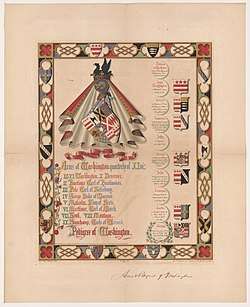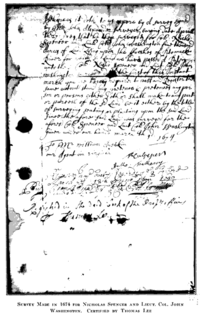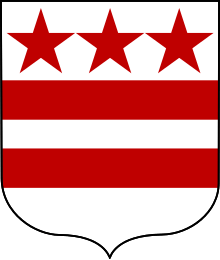John Washington
John Washington (1631–1677) was an English planter, soldier, and politician in colonial Virginia in North America. He was a lieutenant colonel in the local militia. Born in Hertfordshire, England, he settled in Westmoreland County, Virginia. He is the patriarch of the Washington family, being the colonist paternal English ancestor and great-grandfather of George Washington, general of the Continental Army and first president of the United States of America.
John Washington | |
|---|---|
| Born | 1631 Tring, Hertfordshire, England |
| Died | 1677 (aged 46) Washington Parish, Westmoreland County, Colony of Virginia, English America |
| Occupation | Planter, soldier, politician |
| Spouse(s) | Anne Pope Anne, widow of Henry Brett Frances Gerard, widow of John Appleton |
| Children | Lawrence Washington John Washington II Anne Washington |
| Parent(s) | Lawrence Washington Amphillis Twigden |

Early life and family
John Washington was possibly born about 1631[1][2] in Tring, Hertfordshire, England.[3] This birth year is based on a deposition he gave about 5 January 1675:6 that says he was age 45. Other people believe he was born between February and May 1634. This is based on an estimated marriage date of May – June 1633 for his parents.[4] He was the son of Rev. Lawrence Washington (1602–1652) and Amphillis Twigden.[5] At the time of his marriage, Lawrence Washington was a don at the University of Oxford.
When John was eight his father enrolled him in Charterhouse School in London to begin preparing for an academic career, but the boy never attended the school. In 1633 the senior Washington had left Oxford when called as the Rector of Purleigh, Essex. During the English Civil War, in 1643 the royalist Washington was stripped of his clerical position by the Parliamentary Puritans. He was reduced to serving as a Vicar of an impoverished parish in Little Braxted, Essex. His wife and family returned to her parents' family home in Tring, Hertfordshire.
John Washington was apprenticed with a London merchant through the help of his Sandys relatives. He gained a valuable education in colonial trade, as England had colonies in the Caribbean and North America.
In 1656 John Washington invested in a merchant ship engaged in transporting tobacco from North America to European markets; he sailed it from England for the Colony of Virginia.[6] Washington served as the ship's second officer. In 1657, the ship foundered in the Potomac River. Although the vessel was repaired, Washington elected to remain in the colony.[7] He was accompanied[8] to Virginia by his cousin, James Washington, the son of Robert Washington (1616 - 1674), who worked in the London-Rotterdam trade of the Merchant Adventurers.[9] James subsequently returned to England.[8]

Colony of Virginia
While first in Virginia, Washington stayed at the house of Col. Nathaniel Pope, a planter. During this stay, he fell in love with his host's daughter Anne. He settled at a site on Bridges Creek.[10]
After his marriage to Anne Pope, the couple received a wedding gift from Anne's father of 700 acres (2.8 km2) on Mattox Creek in Westmoreland County of the Northern Neck.[7] Washington became a successful planter, depending on the labour of African slaves and British indentured servants to cultivate tobacco as a commodity crop and the necessary kitchen crops to support the household and workers. He was selected for the Virginia House of Burgesses and became a politician in the colony.[7]
In 1674, he received a 5,000 acres (2,000 ha) land grant, adding to his estate and power. (See image)
During the events leading to Bacon's Rebellion in 1676, Washington was appointed a colonel in the Virginia militia. He led a company to back a group of Marylanders during a planned parley with the disgruntled opposition and their allied American Indian leaders. The militia killed six chiefs of various tribes. Outraged, their peoples later retaliated, conducting raids and attacks against the colonists.[11] Governor William Berkeley strongly criticised Washington for the murders of the American Indian chiefs, but colonists supported him.[12] The Governor would later be replaced by John's cousin Nicholas Spencer who had traveled with him on his ship. Relations between the Indians and colonists deteriorated.[13]
Marriage and family
John Washington married Anne Pope in 1658.[5] He wrote a letter to Gov. Josias Fendall of Maryland dated 30 September 1659, which states that his "young sonne" will be baptised on 4 October 1659. This suggests he was married at least 9 months before 30 September, possibly in late 1658.
They had the following children[14] together:
- Lawrence Washington (1659–1698),
- John Washington II (1661–23 Feb 1698)
- Anne Washington (b.c. 1662–1697)[5]
- 2 additional children, names unknown, mentioned as deceased when he wrote his will on 21 September 1675
After Anne Pope's death, Washington married Anne Brett, a widow, who had been married first to Walter Broadhurst and secondly to Henry Brett, who both died.[2]
After his second wife's death, John Washington married Frances Gerard (a daughter of Dr. Thomas Gerard, and widow of Thomas Speke, Valentine Peyton, and John Appleton). This third marriage occurred about 10 May 1676[15] when a "joynture" was recorded between Mrs. Frances Appleton and John Washington in Westmoreland County, Virginia.
Washington died before 26 September 1677, when the Westmoreland County, Virginia Order Books record the following: "ye sherrife is confirme ye extr or admstr of ye sd Coll Washington to prove ye debt".[16] John and his first wife Anne Pope are buried near present-day Colonial Beach, Virginia, at what is now called the George Washington Birthplace National Monument. His vault is the largest in the small family burial plot.
Legacy and honours
The name of the local parish of the Anglican Church (the established church in colonial Virginia, and thereby also a tax district of the county) was changed to Washington in his honour.[7]
See also
Bibliography
- Randall, Willard Sterne (1997). George Washington: A Life. New York: Holt & Co.
References
- Westmoreland Co, VA Deeds, Patents & Wills, 1665–1677, p. 247a, 5 January 1675:6, deposition of Col. John Washington, age 45.
- William and Mary College (31 October 1896). "William and Mary College Quarterly Historical Magazine, Washington & His Neighbors". William and Mary College. – via Google Books.
- "Tring Local History Museum". 28 October 2017. Archived from the original on 28 October 2017. Retrieved 5 December 2019.
- "WikiTree, John Washington".
- "John Washington and His Descendants". kenmore.org.
- Murray Neil. "The Washingtons of Tring". Hertfordshire Genealogy. Retrieved 3 April 2015.
- Haas, Irvin (1992). Historic Homes of the American Presidents. Courier Dover Publications. p. 7. ISBN 0-486-26751-2.
- "a veteran diplomat" (3 September 1916). "Baron George Washington Fighting for Austria; Collateral Descendant of the First President of U.S., an Officer of the Austrian Lancers, May Make New Yorker His Heir". The New York Times. Retrieved 2 August 2009.
- Clay, J. W. (1899). Dugdale's Visitation of Yorkshire, With Additions, Vol. I. William Pollard and Co., Exeter. pp. 234–235.
- Marquis, A.N. Company. Who's Who in America, vol. 1: Historical Volume (1607–1896), revised ed., Marquis, A.N. Company., 1967.
- Richardson, Abby Sage (1875). The History of Our Country: From Its Discovery by Columbus to the Celebration of the Centennial Anniversary of the Declaration of Independence. H. O. Houghton and Company. p. 135.
- Nicholas Spencer
- Lodge, Henry Cabot (1917). George Washington. Houghton Mifflin. p. 36.
- Westmoreland Co, VA Deeds, Patents & Wills, 1665–1677, pp. 365a–367, will of John Washington.
- Westmoreland Co, VA Deeds, Patents & Wills, 1665–1677, pp. 274a–275a, 10 May 1676, Jno Washington joynture with Fra Appleton.
- Westmoreland Co, VA Order Book, 1675–1689, p. 88, 26 September 1677, executor of Col. Washington.
